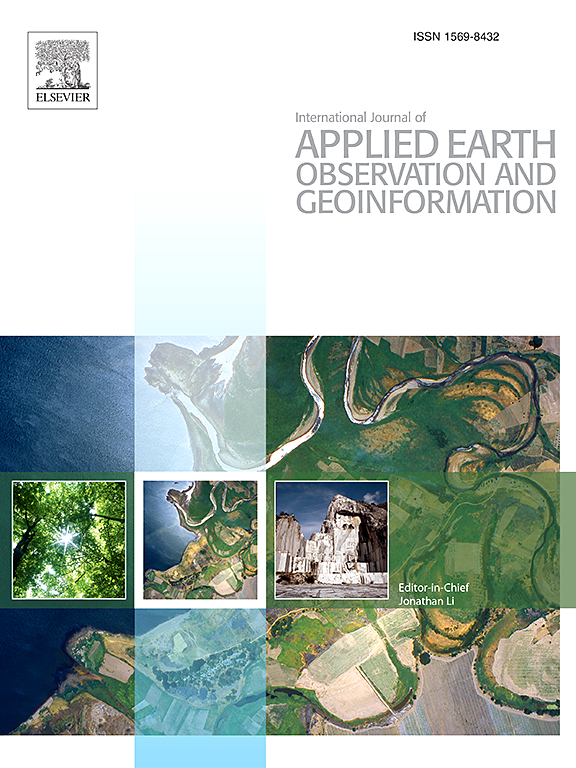Combining multi-source data to investigate vessel wake temperature gradients and dynamic patterns
IF 7.6
Q1 REMOTE SENSING
International journal of applied earth observation and geoinformation : ITC journal
Pub Date : 2025-03-31
DOI:10.1016/j.jag.2025.104509
引用次数: 0
Abstract
The movement of a vessel generates cold and warm wake patterns with temperature gradients on the sea surface, which provide detection possibilities for satellite-based infrared detection systems. This work analyzes the temporal characteristics of ship wake dissipation on the sea surface, based on multi-source data from low Earth orbit satellite thermal infrared imaging, Automatic Identification System (AIS) data, and numerical simulation results, revealing the dynamic information contained within the thermal wake. The temperature images of sea surface thermal wakes generated by vessels at different speeds were obtained using numerical simulation methods. The thermal infrared characteristics of the surface vessel wakes were verified using images from the thermal imaging spectrometer aboard the SDGSAT-1 satellite. The simulation results reveal the patterns of generation, diffusion, and attenuation of the infrared thermal wake produced by moving vessels in the ocean. By combining simulations with infrared images from the SDGSAT-1 satellite, the thermal infrared temperature characteristics of wakes on the sea surface are summarized. This method overcomes the limitations of traditional optical monitoring techniques at night, while capturing more information on sea surface temperature variations. By deeply exploring sea surface thermal signature data, this paper provides technical support for all-weather vessel speed inversion using single-satellite data.
结合多源数据研究船舶尾流温度梯度和动态模式
船只的运动在海面上产生具有温度梯度的冷热尾流模式,这为基于卫星的红外探测系统提供了探测可能性。本文基于近地轨道卫星热红外成像、自动识别系统(AIS)数据和数值模拟结果,分析了船舶尾流在海面上耗散的时间特征,揭示了热尾流内部的动态信息。采用数值模拟方法获得了不同航速下船舶产生的海面热尾迹的温度图像。利用SDGSAT-1卫星上的热成像光谱仪图像验证了水面舰船尾迹的热红外特性。模拟结果揭示了海洋中移动船只产生的红外热尾流的产生、扩散和衰减规律。结合SDGSAT-1卫星的红外图像,总结了海面尾迹的热红外温度特征。该方法克服了传统的夜间光学监测技术的局限性,同时获得了更多的海面温度变化信息。通过深入挖掘海面热特征数据,为单星数据全天候船舶航速反演提供技术支持。
本文章由计算机程序翻译,如有差异,请以英文原文为准。
求助全文
约1分钟内获得全文
求助全文
来源期刊

International journal of applied earth observation and geoinformation : ITC journal
Global and Planetary Change, Management, Monitoring, Policy and Law, Earth-Surface Processes, Computers in Earth Sciences
CiteScore
12.00
自引率
0.00%
发文量
0
审稿时长
77 days
期刊介绍:
The International Journal of Applied Earth Observation and Geoinformation publishes original papers that utilize earth observation data for natural resource and environmental inventory and management. These data primarily originate from remote sensing platforms, including satellites and aircraft, supplemented by surface and subsurface measurements. Addressing natural resources such as forests, agricultural land, soils, and water, as well as environmental concerns like biodiversity, land degradation, and hazards, the journal explores conceptual and data-driven approaches. It covers geoinformation themes like capturing, databasing, visualization, interpretation, data quality, and spatial uncertainty.
 求助内容:
求助内容: 应助结果提醒方式:
应助结果提醒方式:


